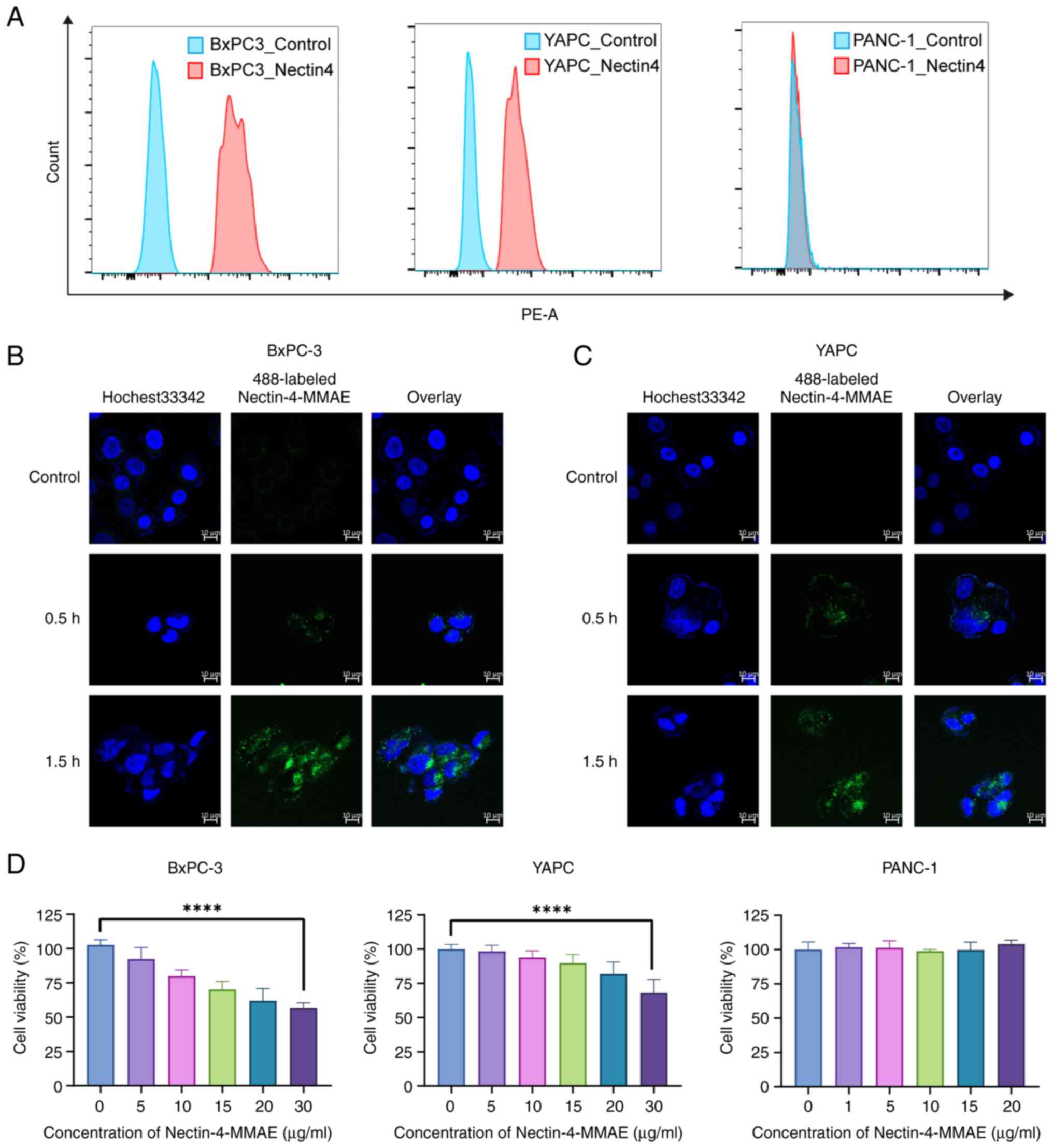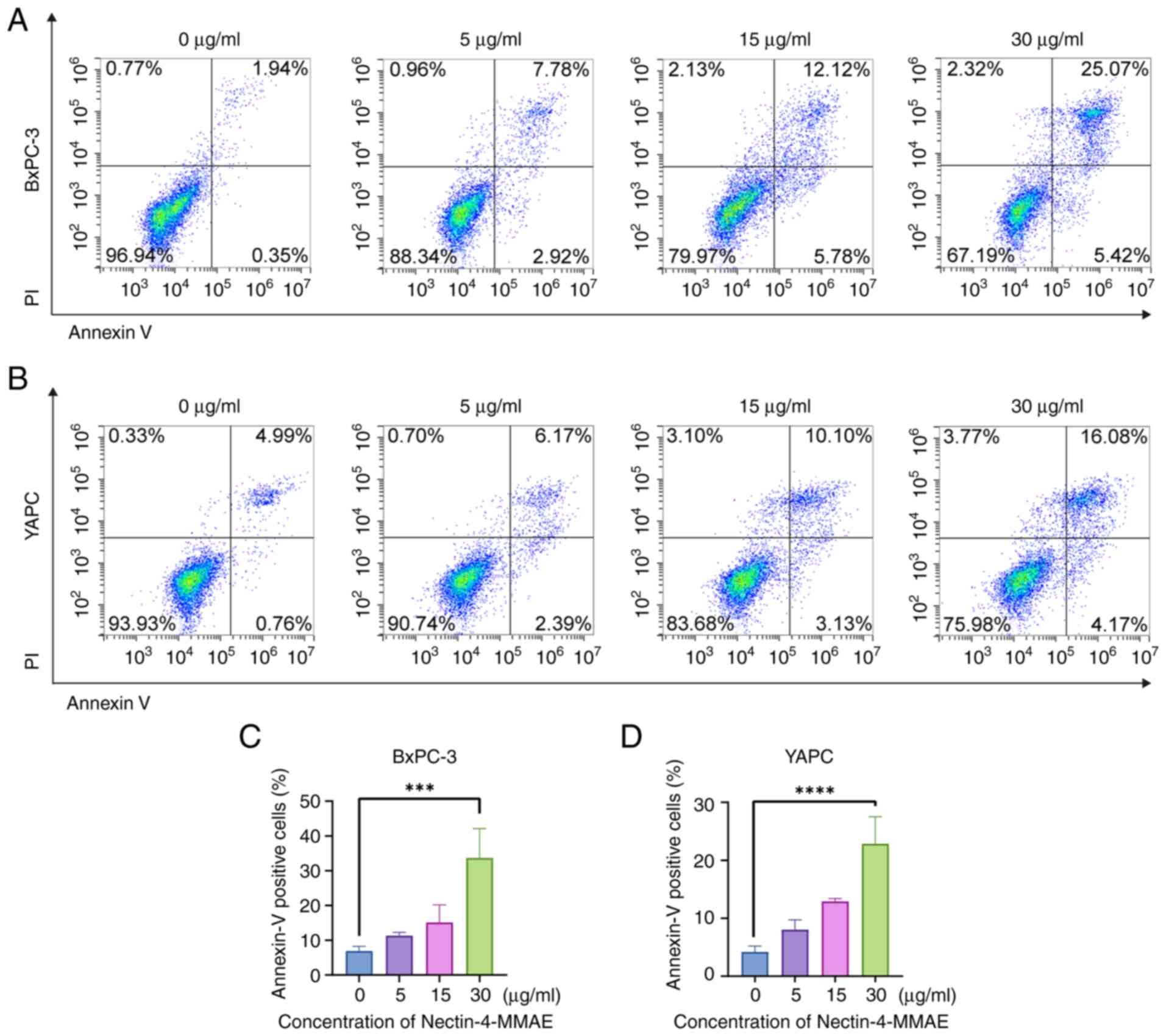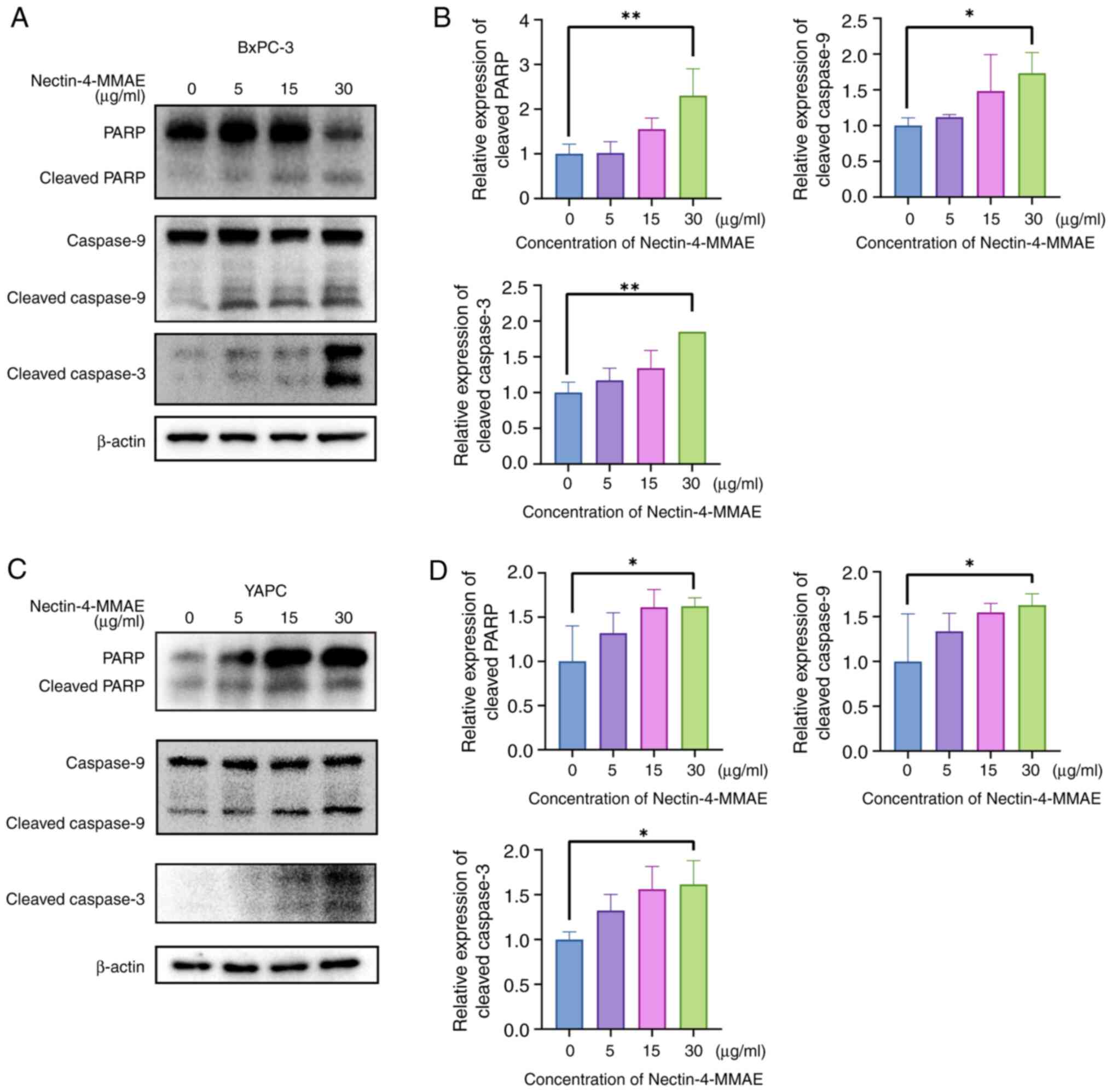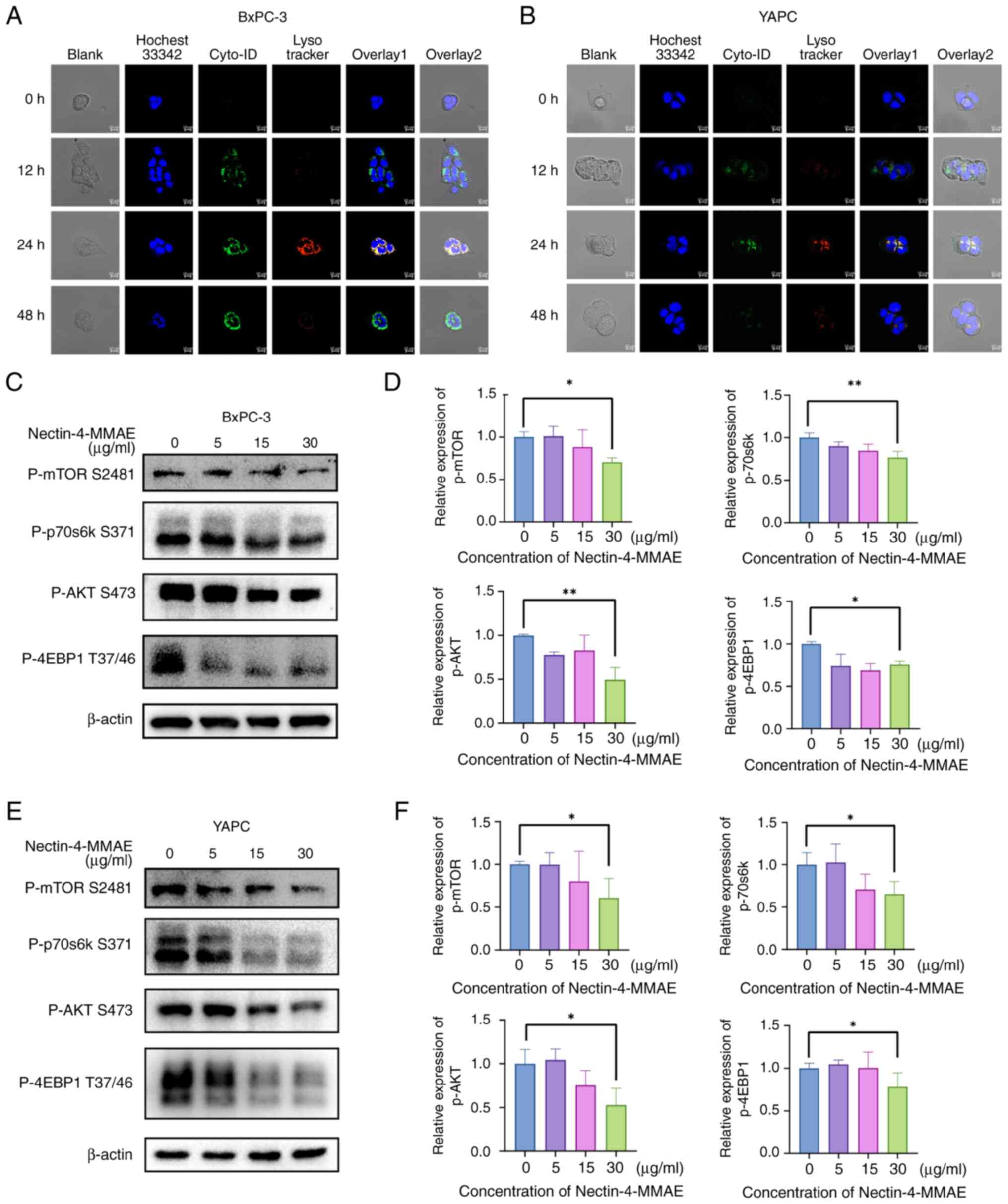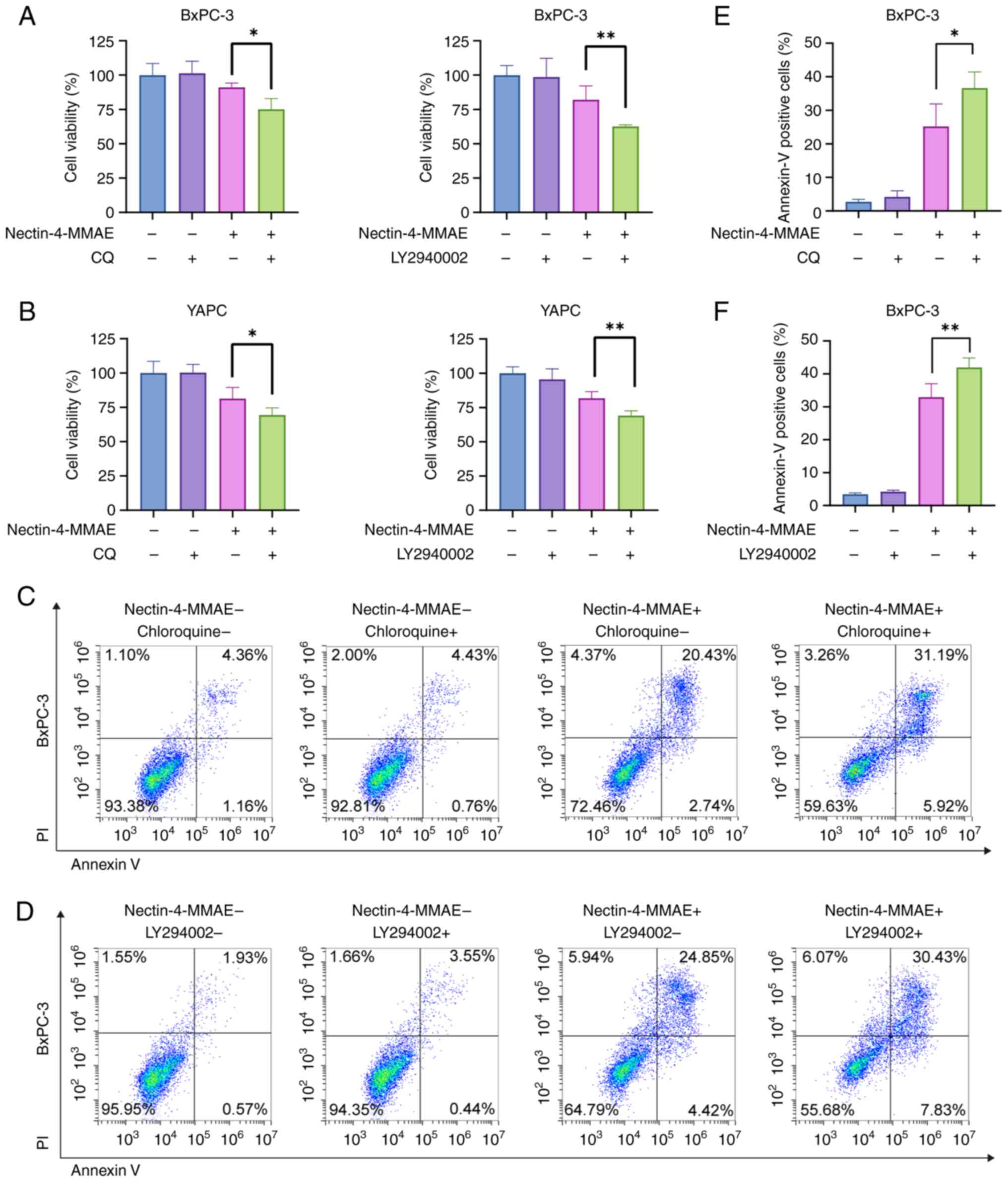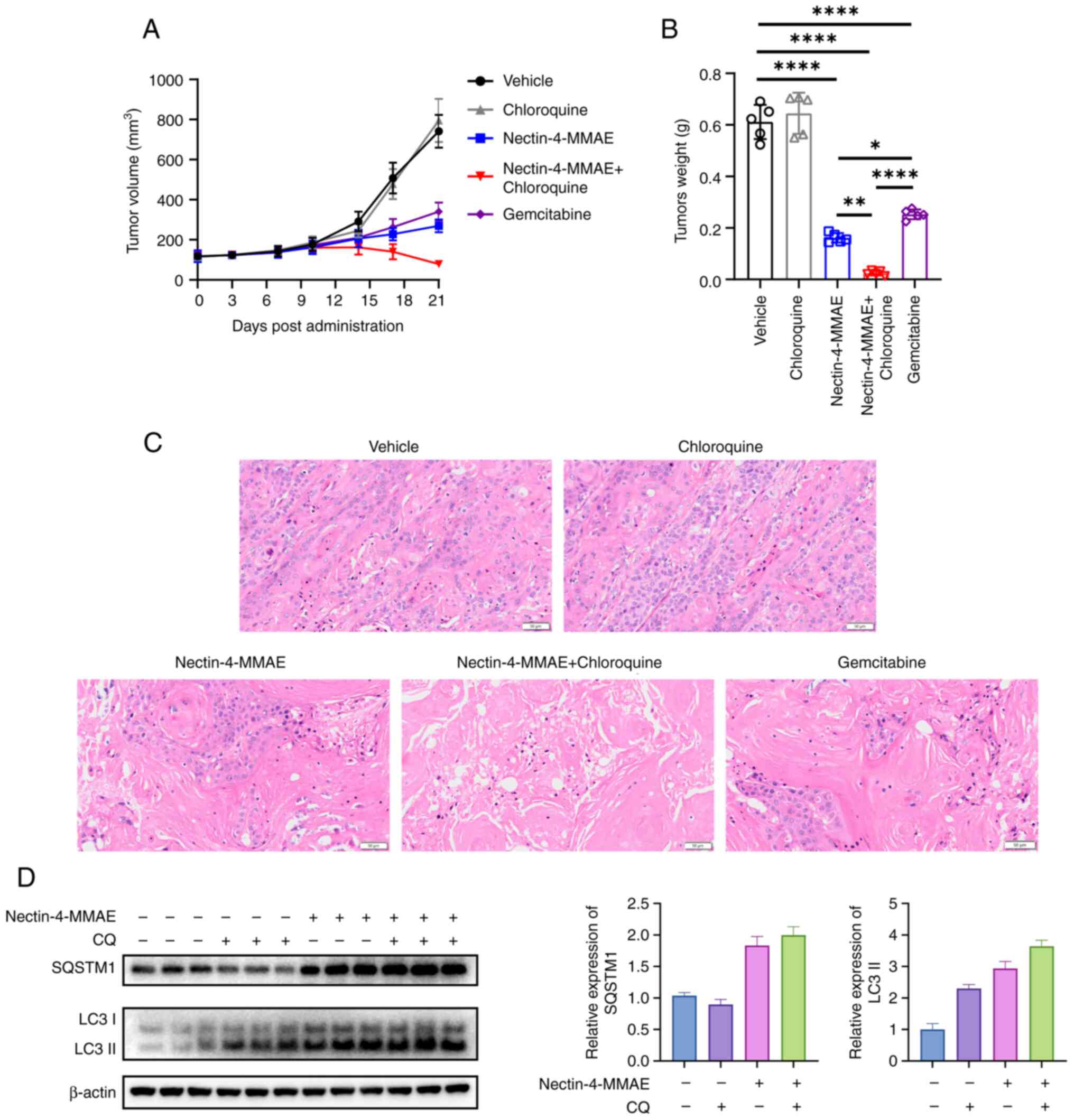A novel and promising therapeutic approach for treating pancreatic cancer: Nectin‑4‑targeted antibody‑drug conjugates alone or combined with autophagy inhibitors
- Authors:
- Published online on: February 24, 2025 https://doi.org/10.3892/ijmm.2025.5507
- Article Number: 66
-
Copyright: © Fu et al. This is an open access article distributed under the terms of Creative Commons Attribution License.
Abstract
Introduction
Pancreatic cancer is a highly lethal cancer, accounting for nearly 5% of cancer-related deaths worldwide (1). Numerous patients with pancreatic cancer are diagnosed in the late stages of the disease because there are no apparent symptoms, resulting in missed opportunities for surgical treatment. The main treatments for pancreatic cancer are pancreatectomy and drug chemotherapy, but the prognosis for patients is poor. Despite advances in combination chemotherapy, the median survival of patients with pancreatic cancer is only 10-12 months (2,3). Due to the limited efficacy of current treatment options, targeted therapies are receiving attention for addressing this unmet clinical need (4). Of significant note, antibody-drug conjugates (ADCs) have become a popular research topic in antitumor drug development, combining the advantages of precise targeting and efficient elimination to achieve exact and efficient elimination of cancer cells. Since the U.S. FDA first approved the ADC drug Mylotarg in 2000, 13 ADCs have reached the market. However, no ADCs have yet been authorized by the FDA for the treatment of pancreatic cancer (5). ADC treatment for pancreatic cancer has shown promise in preclinical studies. Presently, clinical trials of ADC drugs targeting pancreatic cancer are also underway, including ADCs targeting claudin18.2: SHR-A1904 (NCT04928625), TROP2: IMMU-132 (NCT01631552) and c-MET: RC108 (NCT05628857). Despite the advances in the efficacy of these ADCs in the treatment of pancreatic cancer, there are few studies investigating the specific mechanisms of ADCs in pancreatic cancer, and no studies of Nectin-4-targeted ADCs in pancreatic cancer have been reported to the best of the authors' knowledge.
Nectin-4, a type I transmembrane cell adhesion protein, is expressed at low levels in adults under physiological conditions and overexpressed in various tumor tissues, and therefore is an attractive antigen target for ADC (6). The first FDA-approved Nectin-4-targeted ADC, enfuzumab vedotin, is a treatment for urothelial cancer (7). According to the literature, the overall positivity rate of pancreatic cancer for Nectin-4 was reported to be ~71%, and the expression of Nectin-4 in pancreatic cancer tissue was markedly higher than that in normal pancreatic tissue (8). Another study found that Nectin-4 may be closely associated with Capan-2 and BxPC-3 cell proliferation. Nectin-4 may contribute to tumor cell proliferation in human pancreatic cancer, according to immunohistochemistry experiments (9). These findings suggest that Nectin-4 may be a potential target in pancreatic cancer and that Nectin-4-targeted ADCs may be a potential therapeutic agent to support further clinical studies and treatment. In the present study, experiments were performed using Nectin-4-MMAE, 9MW2821, which consists of an anti-Nectin-4 antibody (MW282 mAb), the IDconnect linker and the cytotoxic molecule MMAE.
Autophagy is an important regulator of cancer cell metabolism, and its role in various solid tumors is dynamic and dependent on the environment (10,11). On the one hand, autophagy is a cytoprotective mechanism that degrades damaged, degenerated and senescent cells to provide raw materials for cell regeneration and repair (12). On the other hand, excessive autophagy leads to metabolic stress and cell death (13,14). Tumor cells induce autophagy under hypoxic and starvation conditions; inhibiting autophagy significantly increases tumor death and suppresses tumor cell proliferation (15). Wang et al (16) reported that a combination of Nectin-4-MMAE and autophagy inhibitors exhibited synergistic antitumor effects in bladder cancer. The mechanism of autophagy in Nectin-4-MMAE treatment of pancreatic cancer also merits further exploration.
The present study aimed to investigate the possible antitumor effects of Nectin-4-MMAE on pancreatic cancer both in vivo and in vitro. Moreover, the current study delved into the significant roles of autophagy and apoptosis in Nectin-4-MMAE-induced pancreatic cancer cell death. Autophagy inhibitors were combined with Nectin-4-MMAE to evaluate the possibility of enhancing its antitumor effects and to explore the feasibility of this combination therapy for treating pancreatic cancer.
Materials and methods
Reagents and antibodies
9MW2821 was provided by Mabwell (Shanghai) Biotechnology Co., Ltd. LY294002 was purchased from Selleck Chemicals (cat. no. S1105). Antibodies from Cell Signaling Technology, Inc. used in the present study were as follows: anti-PARP antibody (cat. no. 9542), anti-cleaved caspase-9 antibody (cat. no. 9502), anti-cleaved caspase-3 antibody (cat. no. 9662), anti-phospho-AKT antibody (Ser473; cat. no. 4060), anti-phospho-mTOR antibody (Ser2448; cat. no. 2971), anti-phospho-p70s6k antibody (Ser371; cat. no. 9208), anti-phospho-4EBP1 antibody (Thr45; cat. no. 2855), anti-LC3 antibody (cat. no. 3868) and anti-SQSTM1 antibody (cat. no. 8025). All of the primary antibodies were derived from rabbits and the dilution ratio was 1:1,000. HRP-conjugated anti-rabbit IgG secondary antibody (1:3,000; cat. no. 7074; Cell Signaling Technology, Inc.) and anti-β-actin antibody (rabbit; 1:5,000; cat. no. GB15003-100; Wuhan Servicebio Technology Co., Ltd.) were also used.
Cell culture
The human pancreatic cancer cell lines BxPC-3, YAPC and PANC-1 were purchased from the Shanghai Typical Cultures Depository of the Chinese Academy of Sciences. PANC-1 cells were cultivated in DMEM media (cat. no. MA 0212; Dalian Meilun Biology Technology Co., Ltd.), while BxPC-3 and YAPC cells were cultured in RPMI-1640 media (cat. no. MA 0215; Dalian Meilun Biology Technology Co., Ltd.). Cell lines were maintained in an environment with 5% carbon dioxide, suitable humidity, and a temperature of 37°C. It was confirmed that all cell lines are mycoplasma-free through routine mycoplasma testing.
Cellular Nectin-4 expression assay
Cells were resuspended in ice-cold PBS. Then 100 µl (1×106 cells/ml) of the cell suspension and 2 µg/ml of anti-Nectin-4 antibody were added to a centrifuge tube. The suspension was incubated for 30 min at 4°C while being protected from light. The cells were washed three times and fluorescent-conjugated secondary antibody (1:1,000; cat. no. 398004; BioLegend, Inc) was added to the appropriate tubes. The suspension was incubated at 4°C in the dark for 30 min. After washing the cells three times, they were resuspended in PBS for subsequent analysis. Cells were analyzed by flow cytometry (CytoFLEX; Beckman Coulter, Inc.) using the software CytExpert 2.4 (Beckman Coulter, Inc.).
Cell viability assay
After the indicated co-incubation time, 100 µl of MTT solution (cat. no. MB4698; Dalian Meilun Biology Technology Co., Ltd.) was added to the cells and incubated at 37°C for 4 h. The methylated product was dissolved with DMSO, and the plates were gently shaken at room temperature for 5 min. An enzyme marker was used to detect the absorbance at 490 nm.
Confocal microscopy
The internalization of ADCs and the subsequent autophagic flow were investigated using confocal fluorescence imaging. Using an Alexa Fluor® 488 Protein Labelling Kit (cat. no. A10235; Thermo Fisher Scientific, Inc.), the ADCs were labeled with Alexa Fluor® 488 and incubated for the specified amount of time. ADCs were then applied to YAPC and BxPC-3 cells for specified durations. Autophagosomes and lysosomes were identified using a Cyto-ID Autophagy Detection Kit (cat. no. ENZO-51031K200; Enzo Life Sciences, Inc.). The cells were observed using a Carl Zeiss LSM710 (Carl Zeiss AG) confocal microscope.
Western blot analysis
The cells were lysed using RIPA buffer (cat. no. P0013D; Beyotime Institute of Biotechnology). The total protein concentration was measured after the supernatant was collected using the BCA Protein Assay Kit (cat. no. P0012; Beyotime Biotechnology). Loading buffer was added and the proteins were heated for 8 min at 100°C to denature the proteins. SDS-PAGE gels (8-15%) were loaded with equal volumes of proteins (20 µg per lane) and then underwent electrophoretic separation. The proteins were subsequently transferred to a PVDF membrane. Next, the membrane was blocked with 5% BSA (cat. no. MB4219; Dalian Meilun Biology Technology Co., Ltd.) for 2 h at room temperature, and incubated overnight with the primary antibody at 4°C, followed by the secondary antibody for 2 h at room temperature. Using an ECL kit (cat. no. MA0186; Dalian Meilun Biology Technology Co., Ltd.), the membrane protein bands were observed. Imaging was performed using a gel imager from Bio-Rad Laboratories, Inc. Densitometric analysis was carried out using Image LAB 5.2 software, and the grayscale values of the bands were calculated using ImageJ (National Institutes of Health).
Apoptosis analysis
Apoptosis was identified by using the Annexin V-FITC/PI Apoptosis Detection Kit (cat. no. MA0220; Dalian Meilun Biology Technology Co., Ltd.). Cells were processed and stained according to the manufacturer's protocol. After 1×105 cells were centrifuged, the supernatant was discarded. 195 µl of Annexin V-FITC binding buffer was added and the cells were gently resuspended. Then, 5 µl of Annexin V-FITC and 10 µl of propidium iodide staining solution were added and gently mixed. Incubate the samples in the dark for 15 min before performing the detection on the instrument. Using a flow cytometer, cells were found and examined (CytoFLEX; Beckman Coulter, Inc.) using the software CytExpert 2.4 (Beckman Coulter, Inc.).
Transmission electron microscopy
The autophagic structure of BxPC-3 cells was determined using transmission electron microscopy. When the cell density was ~70%, the cells were digested with EDTA-free digestive enzymes. After centrifugation (300 × g, 3 min, 20°C), the supernatant was discarded and the cells were fixed using 2.5% glutaraldehyde fixative. The samples were kept at 4°C. The embedding, sectioning and subsequent image acquisition work were entrusted to Wuhan Servicebio Technology Co., Ltd. The samples were recorded using a transmission electron microscope at magnifications of ×1,500 and ×6,000.
Tumor xenograft model
BALB/c nude male mice (n=25, 18 g, 6-weeks old) were purchased from the Shanghai Model Organisms Center. Male mice based the stable hormone level making it easier to determine the antitumor efficacy of ADCs. All animals were kept in the Experimental Animal Center of Fudan University under a 12/12 h light/dark cycle (17). The temperature in the animal room was controlled between 20-26°C. The mice were given full access to regular food and water during the study. BxPC3 cells suspended in PBS were subcutaneously injected at a density of 1×107 cells per mouse to establish mouse xenograft tumor model. A total of 5 groups of mice were randomly selected, with 5 mice in each group. The treatments were as follows: Intraperitoneal injection of PBS; single dose intravenous injection of Nectin-4-MMAE (3 mg/kg); intraperitoneal injection of chloroquine (50 mg/kg; cat. no. C6628; MilliporeSigma) once a day; combination of Nectin-4-MMAE and CQ; and twice a week intravenous injection of the positive control drug gemcitabine (50 mg/kg). Tumor volume in mice was calculated by measuring length and width (volume=0.5 × length × width2). After 21 days of drug administration, the experimental animals were euthanized by cervical dislocation operation. The researchers observed the mice directly for undulating movements of the chest to determine respiratory arrest. At the same time, the left side of the mice's chest was gently touched with a finger to determine whether the heartbeat had stopped by touch. When the mice's vital signs completely stopped and there was no sign of recovery after continuous observation, the mice's death status was formally confirmed, and then the subsequent experimental process steps were carried out. Sections of excised tumor tissue were prepared for H&E staining.
Hematoxylin and eosin (H&E) staining
Sectioning and H&E staining were both entrusted to Wuhan Servicebio Technology Co., Ltd. The tumor tissue was collected and fixed in a 4% paraformaldehyde solution for 24 h. Subsequently, paraffin embedding was carried out, and the tissue was sectioned into slices with a thickness of 3-4 µm. The slices were then deparaffinized in xylene and hydrated through a series of alcohol solutions with decreasing concentrations. Next, the slices were stained with H&E. After staining, the slices were dehydrated with anhydrous ethanol and made transparent with xylene. Finally, the treated slices were mounted and observed under the Whole Slide Scanning System (Olympus VS200).
Statistical analysis
Adobe Photoshop and Illustrator were used to create the graphs. GraphPad Prism 8.3 (Dotmatics) and Excel (version 2019; Microsoft Corporation) were used to analyze the data, and the results of three independent replicate experiments are shown as the mean ± SD. Groups were compared using a one-way ANOVA followed by Dunnett's or Tukey's post hoc tests and the unpaired Student's t-test. P<0.05 was considered to indicate a statistically significant difference.
Results
ADCs targeting Nectin-4 induce apoptosis in pancreatic cancer cell lines
Flow cytometry screening was performed on two Nectin-4 positive pancreatic cancer cell lines, BxPC-3 and YAPC, and 1 Nectin-4 negative cell line, PANC-1, for subsequent experiments (Fig. 1A). YAPC and BxPC-3 cells were cultured with 10 µl (2 µg/ml) of Nectin-4-MMAE labeled with Alexa Fluor® 488. After 30-90 min of treatment, intracellular green fluorescence was observed using laser confocal microscopy, indicating that Alexa Fluor® 488-labeled Nectin-4-MMAE bound to the cell surface receptors and enter the cell for internalization (Fig. 1B and C). Using an MTT assay, it was found that the cytotoxicity of BxPC-3 and YAPC cells increased significantly as the concentration of Nectin-4-MMAE increased after 72 h, while PANC-1 cell viability was not significantly affected (Fig. 1D). The cytotoxicity of ADCs is not potent enough, which might depend on the targets, the cell lines and the properties of ADCs.
To explore the mechanism of cell elimination, cells were analyzed for apoptosis by staining with Annexin V/PI after BxPC-3 and YAPC cells were treated with different concentrations of Nectin-4-MMAE for 72 h. As the concentration of Nectin-4-MMAE within BxPC-3 and YAPC cells rises, the overall number of both early apoptotic and late apoptotic cells similarly increased (Fig. 2A-D). The expression of apoptosis-related proteins was analyzed in YAPC and BxPC-3 cells by western blotting (Fig. 3A and B). As the concentration of Nectin-4-MMAE increased, there was a significant rise in apoptosis-related protein levels. This finding suggested that Nectin-4-MMAE caused cell death by cleaving PARP downstream and through apoptosis by activating the caspase cascade. The results suggested that Nectin-4-MMAE induced apoptosis and cytotoxicity in BxPC-3 and YAPC cells.
Nectin-4-directed ADC induces autophagy in BxPC-3 and YAPC cells
Autophagosomes in BxPC-3 cells after Nectin-4-MMAE treatment were observed using transmission electron microscopy (Fig. 4A). The autophagosomes had a double-membrane structure (marked by red arrows). This result suggested that Nectin-4-MMAE resulted in the production of intracellular autophagic vesicles. To further confirm the relationship between autophagy and ADCs, the cells were divided into three groups: The negative control group, the Nectin-4-MMAE group (15 µg/ml), and the positive control rapamycin group. BxPC-3 and YAPC cells were plated and incubated with the corresponding drugs for 12 h. The cells were stained with the autophagosome dye Cyto-ID and observed by confocal microscopy. It was found that the intensity of green fluorescence significantly increased in the Nectin-4-MMAE groups, which was consistent with the results of the positive control rapamycin group (Fig. 4B and C). In addition, the expression of the autophagy marker protein SQSTM1 decreased as the Nectin-4-MMAE concentration increased, and LC3 II expression increased as the Nectin-4-MMAE concentration increased, suggesting an increase in autophagy (Fig. 4D-F).
Nectin-4-directed ADCs induce autophagy flux in BxPC-3 and YAPC cells
BxPC-3 and YAPC cells were treated with 15 µg/ml Nectin-4-MMAE for different time intervals. Autophagosome formation was detected at 12 h and peaked at 24 h. Lysosome formation was detected in BxPC-3 and YAPC cells after 24 h. After 48 h, lysosomes were observed in BxPC-3 cells, while lysosomes disappeared in YAPC cells. Yellow fluorescence was observed in the merged image at 24 h and disappeared at 48 h, indicating that autophagosomes become autophagic lysosomes and were subsequently degraded. This result demonstrated the entire process of Nectin-4-MMAE-induced autophagic flux (Fig. 5A and B).
To improve understanding of how Nectin-4-MMAE induces autophagy, the phosphorylation levels of the upstream regulators of the classical Akt/mTOR autophagy pathway were further examined through western blotting. It was identified that as the quantity of Nectin-4-MMAE increased, phosphorylated (p)-Akt, p-mTOR, p-p70S6k and p-4EBP1 protein levels dramatically decreased (Fig. 5C-F). These results revealed that the Akt/mTOR signaling pathway was inactivated with increasing concentrations of Nectin-4-MMAE. Combining these results showed that autophagy was induced by inactivating the classical Akt/mTOR pathway, and Nectin-4-MMAE achieved the goal of eliminating tumor cells through autophagy and apoptosis.
Autophagy inhibitors enhance apoptosis induced by nectin-4-directed ADCs
Since autophagy demonstrated a crucial role in the efficacy of Nectin-4-MMAE, it was investigated if autophagy modulators could be combined to further improve efficacy. CQ (5 µM) and LY294002 (3 µM) autophagy inhibitors were chosen for testing with Nectin-4-MMAE. Cell survival was significantly lower in the combination treatment group than in the monotreatment group (Fig. 6A and B). In addition, flow cytometry results demonstrated a significant increase in the proportion of Annexin-V-positive BxPC-3 cells in the combination treatment group but not in the monotreatment group (Fig. 6C-F). Caspase-9 and PARP were more activated in the combination treatment group than in the monotreatment group, as evidence by cleaved protein bands (Fig. 7A and B). The results indicated that combining Nectin-4-directed ADCs with autophagy inhibitors increased apoptosis and produced greater cytotoxicity.
Enhancing the antitumor efficacy of Nectin-4-directed ADC against pancreatic cancer in vivo by inhibiting autophagy
To further confirm the in vitro results, BxPC-3 xenograft tumor models were established to conduct in vivo research. Mice were randomly assigned to the negative control group, Nectin-4-MMAE group, CQ group, CQ and Nectin-4-MMAE group, and positive control drug gemcitabine group. After 21 days of drug administration, the maximum volume of the tumor was 904.74 mm3, maximum length was 13.84 mm and maximum width was 11.73 mm. The volume of tumors in the negative control group was 741.65±82.27 mm3, that in the gemcitabine group was 340.50±44.86 mm3, while the tumor volume in the Nectin-4-MMAE group was 269.38±31.98 mm3, and that in the group treated with the combination of Nectin-4-MMAE and CQ was 79.12±7.62 mm3. Mice treated with Nectin-4-MMAE showed significantly reduced in tumor weights and volumes compared with the negative control group. Mice treated with CQ and Nectin-4-MMAE exhibited significantly reduced tumor weights and volumes compared with the Nectin-4-MMAE alone group (Fig. 8A and B). Tumor tissue was collected from mice in each group, and histological changes were observed through H&E staining. The number of tumor cells was notably reduced in the Nectin-4-MMAE treatment groups, and particularly in the combined treatment group. The size of nucleoli was reduced, nuclear divisions decreased, the density of tumor cells was reduced, and the necrosis rate of the tumor increased (Fig. 8C). Furthermore, the expression levels of autophagy-related proteins in the tumor tissues of mice were detected. CQ is an inhibitor of the late stage of autophagy, which can inhibit the fusion of autophagosomes and lysosomes. The degradation of LC3 II was inhibited, resulting in its accumulation (Fig. 8D). The results suggested that autophagy inhibitors promoted the treatment efficacy of Nectin-4-MMAE in animal models, which was consistent with the results of our cellular experiments.
Discussion
ADCs undergo endocytosis into target cells where they release a cytotoxic drug that causes tumor cell death (18). The cytotoxic drug MMAE in Nectin-4-MMAE promotes tubulin polymerization to perturb microtubule growth (19). The specific protease caspases cause cell death by cleaving a variety of protein substrates, which are also molecular markers of apoptosis (20). The present study found that Nectin-4-MMAE demonstrated significant cytotoxicity and triggered caspase-dependent apoptosis in Nectin-4-positive pancreatic cancer cells. ADC-related research is progressing rapidly and has achieved improved therapeutic effects in the treatment of some solid tumors. Autophagy is a double-edged sword. Autophagy and apoptosis are closely related to each other, as autophagy can promote cell death in concert with apoptosis or antagonize apoptosis by promoting cell survival (21,22). The link between apoptosis and autophagy is complex and diverse, and the signals that activate autophagy usually derive from various stress conditions (23). The present study showed that Nectin-4-MMAE induced the conversion of LC3-I to LC3-II and activated autophagy in pancreatic cancer-positive cells. LC3-I is the precursor of LC3-II. LC3-II is a docking site covalently attached to cargo receptors on the membrane of phagosomes. The receptor binds to the docking site, forming a core that selectively recruits cargo. The phagosome then elongates and closes to form a separate autophagosomal compartment (24). The proximal lysosome and autophagosome then combine to produce an autophagic lysosome. In the presence of lysosomal hydrolases, the cargo is degraded and nutrients are recycled. This process was observed using electron microscopy and confocal microscopy. Xu et al (25,26) first reported that HuNbTROP2-HSA-MMAE significantly induced caspase-dependent apoptosis in pancreatic cancer cells and activated cytoprotective autophagy, which was consistent with the results of the present study.
The AKT/mTOR pathway is crucial to tumor development and has been implicated in the development of various malignant tumors, including pancreatic cancer. In patients with pancreatic cancer, 92% were found to have a KRAS mutation, which activates the AKT/mTOR pathway, leading to alterations in cell cycle progression and survival (27,28). mTOR consists of two multiprotein complexes, mTORC1 and mTORC2. By modifying protein synthesis, mTORC1 controls metabolism, whereas mTORC2 predominantly enhances cell survival and regulates apoptosis. mTORC1 is over-activated in a high proportion of human cancers and forms an autophagy-regulating complex that affects autophagic vesicles. Once activated, mTORC1 promotes cellular energy synthesis and metabolism by phosphorylating the downstream effectors p70S6 kinase 1 and eIF4E-binding protein (29). mTORC1 mainly promotes energy synthesis, metabolism, autophagy inhibition and lysosome formation. mTORC2 mainly promotes cell survival and regulates apoptosis. After the BXPC-3 and YAPC cells were treated with with Nectin-4-MMAE, significantly reduced levels of p-Akt and mTOR were observed, along with the downstream proteins 4EBP1 and p70S6K. This demonstrated that Nectin-4-MMAE treatment enhanced autophagy in pancreatic cancer cells, and tumors were successfully suppressed.
Tumors disrupt overall homeostasis and biological rhythms in the body and promote tumor growth, and increased autophagy promotes cell survival in the face of environmental stresses such as nutrient deprivation (30,31). There are two ways in which malignant tumors affect body homeostasis: i) producing neurohormonal modulators that act on nerve terminal receptors after entering the circulatory system; and ii) activating circulating immune cells to regulate the function of other organs (32). Autophagy may primarily play a cytoprotective role, by maintaining energy homeostasis and nutrient requirements under starvation conditions (25,33). CQ is a late-phase autophagy inhibitor that impairs acid-dependent autophagy by increasing intra-lysosomal pH. Nectin-4-MMAE-induced autophagy can be inhibited by autophagy inhibitors such as CQ. When combined, Nectin-4-MMAE and autophagy inhibitors significantly enhanced the cytotoxic effects of Nectin-4-MMAE in the treatment of pancreatic cancer. This finding demonstrated the protective role of autophagy when treating pancreatic cancer with Nectin-4-MMAE.
Currently, the clinical application of ADCs in cancer treatment still faces numerous challenges, including off-target toxicity, drug resistance, protein aggregation and immune response. If the antibody molecules in the ADCs have poor selectivity and the target antigen exists in normal tissues, cytotoxic molecules will be delivered into normal cells, thereby causing toxic side effects. The drug resistance of human tumor tissues to ADCs is mediated by multiple factors, including alterations in the transport pathway of ADCs, downregulation of the expression of target antigens, decreased lysosomal processing capacity, overexpression of drug efflux transporters and changes in apoptotic signaling pathways (34). Drug resistance has always been a difficult problem in the treatment of tumors with ADCs. The mechanisms, causes and solutions of drug resistance still urgently need to be studied.
The present study showed that Nectin-4-MMAE exerted potent therapeutic effects on Nectin-4 positive pancreatic cancer. Notably, autophagy was activated and played a vital role in Nectin-4-MMAE-mediated therapeutic effects. Nectin-4-MMAE's therapeutic efficiency was significantly enhanced when combined with autophagy inhibitors, indicating that autophagy inhibition may be a novel approach to enhancing the ADCs' antitumor efficacy. In the future, it is expected that the therapeutic effect on pancreatic cancer will be further improved through an in-depth exploration of the specific mechanism of action of Nectin-4 in pancreatic cancer.
Availability of data and materials
The data generated in the present study may be requested from the corresponding author.
Authors' contributions
XZ and ZD conceived the study. ZD, JX and WZ designed the experiments and proofread the manuscript. RF, CW and TY performed the experiments and prepared the figures. YX and YS analyzed the data. XZ and RF wrote the manuscript. XZ and ZD revised the manuscript. ZD and RF confirm the authenticity of all the raw data. All authors read and approved the final version of the manuscript.
Ethics approval and consent to participate
All animal experimental procedures adhered strictly to the approved (approval no. 2025-01-SY-ZXY-02) guidelines and protocols established by the Animal Ethical Committee of the School of Pharmacy of Fudan University (Shanghai, China).
Patient consent for publication
Not applicable.
Competing interests
The authors declare that they have no competing interests.
Acknowledgments
Not applicable.
Funding
No funding was received.
References
|
Bray F, Laversanne M, Sung H, Ferlay J, Siegel RL, Soerjomataram I and Jemal A: Global cancer statistics 2022: GLOBOCAN estimates of incidence and mortality worldwide for 36 cancers in 185 countries. CA Cancer J Clin. 74:229–263. 2024. View Article : Google Scholar : PubMed/NCBI | |
|
Park W, Chawla A and O'Reilly EM: Pancreatic Cancer: A Review. JAMA. 326:851–862. 2021. View Article : Google Scholar : PubMed/NCBI | |
|
Waters AM and Der CJ: KRAS: The critical driver and therapeutic target for pancreatic cancer. Cold Spring Harb Perspect Med. 8:a0314352018. View Article : Google Scholar : | |
|
Wittwer NL, Brown MP, Liapis V and Staudacher AH: Antibody drug conjugates: Hitting the mark in pancreatic cancer? J Exp Clin Cancer Res. 42:2802023. View Article : Google Scholar : PubMed/NCBI | |
|
Crescioli S, Kaplon H, Wang L, Visweswaraiah J, Kapoor V and Reichert JM: Antibodies to watch in 2025. MAbs;17:24435382025. | |
|
Ungaro A, Tucci M, Audisio A, Di Prima L, Pisano C, Turco F, Delcuratolo MD, Di Maio M, Scagliotti GV and Buttigliero C: Antibody-drug conjugates in urothelial carcinoma: A new therapeutic opportunity moves from bench to bedside. Cells. 11:8032022. View Article : Google Scholar : PubMed/NCBI | |
|
Khosravanian MJ, Mirzaei Y, Mer AH, Keyhani-Khankahdani M, Abdinia FS, Misamogooe F, Amirkhani Z, Bagheri N, Meyfour A, Jahandideh S, et al: Nectin-4-directed antibody-drug conjugates (ADCs): Spotlight on preclinical and clinical evidence. Life Sci. 352:1229102024. View Article : Google Scholar : PubMed/NCBI | |
|
Challita-Eid PM, Satpayev D, Yang P, An Z, Morrison K, Shostak Y, Raitano A, Nadell R, Liu W, Lortie DR, et al: Enfortumab vedotin antibody-drug conjugate targeting nectin-4 is a highly potent therapeutic agent in multiple preclinical cancer models. Cancer Res. 76:3003–3013. 2016. View Article : Google Scholar : PubMed/NCBI | |
|
Nishiwada S, Sho M, Yasuda S, Shimada K, Yamato I, Akahori T, Kinoshita S, Nagai M, Konishi N and Nakajima Y: Nectin-4 expression contributes to tumor proliferation, angiogenesis and patient prognosis in human pancreatic cancer. J Exp Clin Cancer Res. 34:302015. View Article : Google Scholar : PubMed/NCBI | |
|
Kimmelman AC and White E: Autophagy and tumor metabolism. Cell Metab. 25:1037–1043. 2017. View Article : Google Scholar : PubMed/NCBI | |
|
Amaravadi R, Kimmelman AC and White E: Recent insights into the function of autophagy in cancer. Genes Dev. 30:1913–1930. 2016. View Article : Google Scholar : PubMed/NCBI | |
|
van der Vos KE, Eliasson P, Proikas-Cezanne T, Vervoort SJ, van Boxtel R, Putker M, van Zutphen IJ, Mauthe M, Zellmer S, Pals C, et al: Modulation of glutamine metabolism by the PI(3) K-PKB-FOXO network regulates autophagy. Nat Cell Biol. 14:829–837. 2012. View Article : Google Scholar : PubMed/NCBI | |
|
Lahiri V, Hawkins WD and Klionsky DJ: Watch what you (self-) eat: Autophagic mechanisms that modulate metabolism. Cell Metab. 29:803–826. 2019. View Article : Google Scholar : PubMed/NCBI | |
|
Ktistakis NT and Tooze SA: Digesting the expanding mechanisms of autophagy. Trends Cell Biol. 26:624–635. 2016. View Article : Google Scholar : PubMed/NCBI | |
|
Guo JY, Xia B and White E: Autophagy-mediated tumor promotion. Cell. 155:1216–1219. 2013. View Article : Google Scholar : PubMed/NCBI | |
|
Wang Y, Nan Y, Ma C, Lu X, Wang Q, Huang X, Xue W, Fan J, Ju D, Ye D and Zhang X: A potential strategy for bladder cancer treatment: Inhibiting autophagy to enhance antitumor effects of Nectin-4-MMAE. Cell Death Dis. 15:2932024. View Article : Google Scholar : PubMed/NCBI | |
|
Hu Q, Zhao H, Zhou K, Hua X and Zhang X: Scarless circular mRNA-based CAR-T cell therapy elicits superior anti-tumor efficacy. bioRxiv 2024.2008.2005.606578. 2024. | |
|
Fu Z, Li S, Han S, Shi C and Zhang Y: Antibody drug conjugate: The 'biological missile' for targeted cancer therapy. Signal Transduct Target Ther. 7:932022. View Article : Google Scholar | |
|
Adair JR, Howard PW, Hartley JA, Williams DG and Chester KA: Antibody-drug conjugates-A perfect synergy. Expert Opin Biol Ther. 12:1191–1206. 2012. View Article : Google Scholar : PubMed/NCBI | |
|
Wang X: The expanding role of mitochondria in apoptosis. Genes Dev. 15:2922–2933. 2001.PubMed/NCBI | |
|
Zang YD, Wu HJ, Chen XY, Ma ZL, Li CJ, Ma J, Chen XG, Sheng L, Zhang S and Zhang DM: Synthesis and biological evaluation of novel Psidium meroterpenoid derivatives against cisplatin-induced acute kidney injury. J Med Chem. 67:14234–14255. 2024. View Article : Google Scholar : PubMed/NCBI | |
|
Qu L, Liu Y, Deng J, Ma X and Fan D: Ginsenoside Rk3 is a novel PI3K/AKT-targeting therapeutics agent that regulates autophagy and apoptosis in hepatocellular carcinoma. J Pharm Anal. 13:463–482. 2023. View Article : Google Scholar : PubMed/NCBI | |
|
Li Z, Mao L, Yu B, Liu H, Zhang Q, Bian Z, Zhang X, Liao W and Sun S: GB7 acetate, a galbulimima alkaloid from Galbulimima belgraveana, possesses anticancer effects in colorectal cancer cells. J Pharm Anal. 12:339–349. 2022. View Article : Google Scholar : PubMed/NCBI | |
|
Gao W, Wang X, Zhou Y, Wang X and Yu Y: Autophagy, ferroptosis, pyroptosis, and necroptosis in tumor immunotherapy. Signal Transduct Target Ther. 7:1962022. View Article : Google Scholar : PubMed/NCBI | |
|
Xu C, Zhu M, Wang Q, Cui J, Huang Y, Huang X, Huang J, Gai J, Li G, Qiao P, et al: TROP2-directed nanobody-drug conjugate elicited potent antitumor effect in pancreatic cancer. J Nanobiotechnology. 21:4102023. View Article : Google Scholar : PubMed/NCBI | |
|
Xu C, Huang X, Hu Q, Xue W, Zhou K, Li X, Nan Y, Ju D, Wang Z and Zhang X: Modulating autophagy to boost the antitumor efficacy of TROP2-directed antibody-drug conjugate in pancreatic cancer. Biomed Pharmacother. 180:1175502024. View Article : Google Scholar : PubMed/NCBI | |
|
Witkiewicz AK, McMillan EA, Balaji U, Baek G, Lin WC, Mansour J, Mollaee M, Wagner KU, Koduru P, Yopp A, et al: Whole-exome sequencing of pancreatic cancer defines genetic diversity and therapeutic targets. Nat Commun. 6:67442015. View Article : Google Scholar : PubMed/NCBI | |
|
Fang P, You M, Cao Y, Feng Q, Shi L, Wang J, Sun X, Yu D, Zhou W, Yin L, et al: Development and validation of bioanalytical assays for the quantification of 9MW2821, a nectin-4-targeting antibody-drug conjugate. J Pharm Biomed Anal. 248:1163182024. View Article : Google Scholar : PubMed/NCBI | |
|
Xue W, Xu C, Zhang K, Cui L, Huang X, Nan Y, Ju D, Chang X and Zhang X: Enhancing antitumor efficacy of CLDN18.2-directed antibody-drug conjugates through autophagy inhibition in gastric cancer. Cell Death Discov. 10:3932024. View Article : Google Scholar : PubMed/NCBI | |
|
Slominski RM, Raman C, Chen JY and Slominski AT: How cancer hijacks the body's homeostasis through the neuroendocrine system. Trends Neurosci. 46:263–275. 2023. View Article : Google Scholar : PubMed/NCBI | |
|
Chen X, Zeh HJ, Kang R, Kroemer G and Tang D: Cell death in pancreatic cancer: From pathogenesis to therapy. Nat Rev Gastroenterol Hepatol. 18:804–823. 2021. View Article : Google Scholar : PubMed/NCBI | |
|
Mottini C, Auciello FR, Manni I, Pilarsky C, Caputo D, Caracciolo G, Rossetta A, Di Gennaro E, Budillon A, Blandino G, et al: The cross-talk between the macro and micro-environment in precursor lesions of pancreatic cancer leads to new and promising circulating biomarkers. J Exp Clin Cancer Res. 43:1982024. View Article : Google Scholar : PubMed/NCBI | |
|
Dikic I and Elazar Z: Mechanism and medical implications of mammalian autophagy. Nat Rev Mol Cell Biol. 19:349–364. 2018. View Article : Google Scholar : PubMed/NCBI | |
|
García-Alonso S, Ocaña A and Pandiella A: Resistance to antibody-drug conjugates. Cancer Res. 78:2159–2165. 2018. View Article : Google Scholar : PubMed/NCBI |



